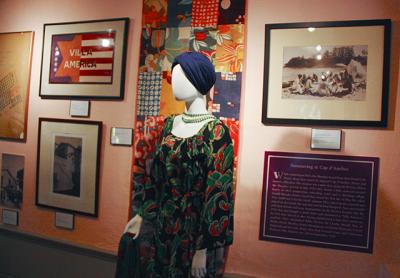Artifacts of a Fabled Life: The Murphys in Paris and East Hampton

We are all accustomed to seeing boldface names associated with the South Fork: Alec, Jimmy, Gwyneth, Sir Paul, et al. Yet, there is something fresh and pulse-quickening about the faces and names of a different century: Pablo, Jean, Cole, Man Ray, Ernest, Scott, and Zelda lighting up the current exhibition “Living Well Is the Best Revenge: A Jazz Age Fable of Sara and Gerald Murphy” at Clinton Academy in East Hampton.
What is the local connection to a bygone era concentrated around Paris and the South of France? Sara Wiborg and Gerald Murphy were two South Fork summer colony kids who were friends long before they married in 1915. They moved to France a few years later with their children in tow and took up residence in a house they dubbed Villa America at Cap d’Antibes on the Riviera. In the 1920s, they hosted many, if not all, of the fabled “Lost Generation” of expatriates who found themselves adrift and abroad between the two world wars.
The Murphys were not only hosts but muses to the creative tribe that gathered at their home. Most famously, F. Scott Fitzgerald cribbed from their lives for his characters Dick and Nicole Diver in “Tender Is the Night.” Picasso painted or drew Mrs. Murphy several times. The couple also inspired books and plays by Ernest Hemingway, John Dos Passos, and Philip Barry.
Their granddaughter, Laura Donnelly, still lives on the South Fork and is The Star’s and East magazine’s food editor. Her family’s heirlooms and objects make up the bulk of the exhibition. Walking with her through the exhibition while it was being installed was a bit like watching a friend unpack an old steamer trunk, similar to the family’s Louis Vuitton traveling wardrobe on view.
There are the romper Sara wore to the beach and one of her day dresses at the entrance, which Ms. Donnelly said she has donned on occasion. A beautiful Chinese dragon robe, once sported by her grandfather and placed near a shaded window, looks as bright and crisp as the day it was made. There are cups and dishes, leather matchbook cases, calling cards, architectural elements, paintings, photographs, wine and champagne glasses, martini picks, Louis Vuitton luggage, and so much more, all evocative of a glamorous and well-lived life.
As the mannequins and vitrines acquired some finishing touches, Ms. Donnelly inquired if there was a way to incorporate some opera-length pearls into the styling for one of the dresses. The photos of Sara on the beach in France wearing such a necklace, tied in a knot and draped down her back, inspired many copycats in her time.
The Wiborgs once owned 600 waterfront acres and the largest house in East Hampton. The family, who came from Cincinnati, built a 19th-century empire from printers ink. The Dunes had 30 rooms and formal gardens.
Up in Boston, Gerald’s father, Patrick Murphy, purchased Mark W. Cross and Company, changed the name slightly, and shifted its focus away from saddles and harnesses to personal leather goods. The company then expanded into selling china, crystal, and other luxury items imported from Europe. He purchased a summer house for the family in Southampton.
The couple met at a party in East Hampton and would come to settle there and in New York, after their youngest child was diagnosed with tuberculosis around 1930. Within two years they lost both of their sons, still in their teens. In 1935, Baoth Murphy died of meningitis. Then, Patrick succumbed to the tuberculosis. There are paintings by Patrick in the show.
The Murphys and their daughter, Honoria, were grief stricken. Ms. Donnelly said her mother secretly feared she would be next. She was 19 when they died. (The entire family is buried in East Hampton at the South End Burial Ground.)
By this time, Murphy, who had pursued landscape architecture and painting, had returned to run Mark Cross for his family. The couple developed their motto, “living well is the best revenge,” in response to their tragedies. It became the title of a book that Calvin Tomkins wrote about them in 1971.
Judging by the objects assembled in the exhibit, living well could be defined by what you acquired and kept around you, the muses you followed, the parties you threw, the clothes you wore to them, and the many creative, sophisticated, intellectual, and famous friends in your circle.
Original artwork by John Dos Passos, enlargements of photographs by Man Ray of the family, an image of the Murphys with Cole Porter and his wife in Venice, a reproduction of one of Gerald’s paintings are as much a part of the show as the silver monogrammed martini picks, cocktail shakers, crystal glassware, jewelry, tableware, and monogrammed beach towels of such a high quality that they are still usable today.
On display is one of a few surviving champagne glasses from a set that Fitzgerald mostly destroyed one night by tossing them over the balcony at dinner. It was an act that caused his banishment from Villa America for several weeks. He wrote several contrite notes until he was let back into Sara’s good graces, said Ms. Donnelly.
Even those unfamiliar with the sparkling life the couple led during one of the most romanticized times and places in history will come away with a solid understanding of their centrality in a group of American expats and European natives helping to define what it meant to be modern. It is a story told in wall text and photos, but most tellingly and touchingly through their objects. The show will remain on view through Oct. 30.
